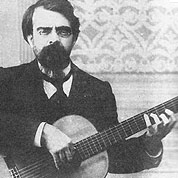Prelude in D minor (Oremus) by Francisco Tarrega
 Tárrega is considered to have laid the foundations for 20th century classical guitar and for increasing interest in the guitar as a recital instrument. Tárrega preferred small intimate performances over the concert stage. Some believe this was because he played without the nails needed for volume. Others say this was related to his childhood trauma. |




Notes
Oremus (Latin for “Let us Pray”) is a short prelude in D minor by composer Francisco Tárrega. This is the final pieces by Tarrega. This piece was written on November 30th 1909 – nearly 2 weeks before Tarrega’s death (15 December). Oremus is often preceded by its brother piece Endecha and the two usually appear together as Endecha – Oremus.
Lento means slowly, Oremus is latin for “Let us pray” and came from an Anglican Church hymn. A handful of chords to remember and a good practice of using the whole neck with chord transition. Part of Tarrega’s genius was his sophisticated and innovative approach to right hand fingering blending melody and accompaniment throughout the fingerboard, thus bring out the full range of tone colors and dynamic possibilities of the guitar
Guitar Demo (Manuel Velazquez)
Tune Low E string to D (Drop D). 9 Bars in Total. Repeat twice with conclude with different endings. Only 2 barre chords. Although played slowly, Left Fingering is important to economize the space between the chord transition. Prelude Oremus starts with the higher end of the guitar (10 fret) and concludes with the lower end of the neck. Although Tuned in Drop D, there is only 1 note that uses this string: the final note. Hardest Measures. Bar[3] and Bar[7]. Prelude Oremus is predominately a left hand song, focus on landing the chords ahead of time.
